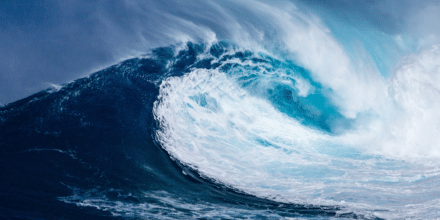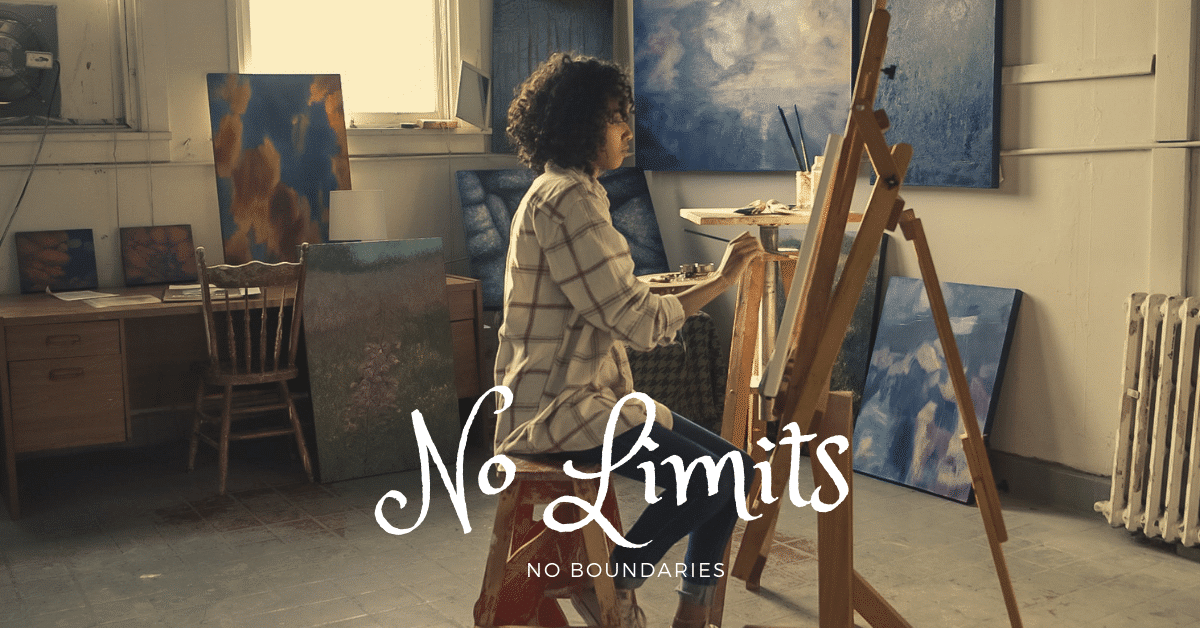To dig into the marketing trends that matter for visual artists in the coming year, CHF interviewed Daniel DiGriz, who works in marketing and brand storytelling and serves as Creative and Education Director at CHF. We asked him specifically about email marketing, e-commerce, and social media. As is often the case, Daniel’s insightful answers are idiosyncratic, punchy, and on-the-nose.
Email Marketing
What are you seeing with email marketing?
Bulk emails—whether they’re sales emails or marketing emails—are experiencing a kind of Renaissance, in my opinion. We’re seeing fewer newsletters (thank goodness), and more unsettled, plain-text, personalized emails with a more human tone. This suits me just fine. I’m much more comfortable dashing off a note from my desk than agonizing over a supremely polished message that is likely to lose my interest as its first reader, and be entirely inoffensive.
Don’t you want it to be inoffensive?
Cafeteria food is inoffensive. Elevator music is inoffensive. And both of them either put you to sleep or make you run. I’d rather a candid email stick out a bit for its daring tone, its honest language, it’s lack of strained rhetoric. I swear in my emails. Not everyone does—that’s fine. But I do, because there’s an art to what I do, and I’m not trying to be the clean-shaven corporate guy. Another way to say this is simply that sales and marketing emails, and marketing in general, are more democratized. People are back to the digital equivalent of loading a sheet of paper in their typewriter and stamping an envelope. Everyone has been able to send bulk emails since the invention of tools like Constant Contact, but what really got democratized along with those tools was the ability to send the lowest common denominator: SPAM and tedious newsletters. I think what we’re seeing now is the democratization of quality. More people are sending better stuff, setting a higher bar, and that sometimes results in making the crap look crappier.
Swear words in emails aren’t offensive to everyone, of course.
Right. Probably even more offensive is that I have a disclaimer at the bottom that says the typos are intentional. I’m focused on being personal, even in a bulk email, and being real, not “sort of cleaned up for prime time.” I’ve seen people—mostly people who are insecure about the stuff they’re sending out—claim anything short of epic proofreading is disrespectful. I think it’s disrespectful to send an email that’s sanitized and, to each their own, but I place a lot of value on not reading what I wrote so closely that I’m apt to find better ways to say it. I want it to be like hearing me on the phone.
Are emails getting longer or shorter?
Both. Emails with something to say—ideas to express—are getting longer. Transaction emails, that are truly transactions like “Want to make sure you got our invitation: please RSVP if you’re coming” are getting shorter. Both respect the user’s time, which is a trend that isn’t a trend: I think it’s a standard that’s here to stay.
Do people really read all the way through the longer emails?
It doesn’t matter. The reason for the length is not so most people will read every word. It’s to do justice to the idea or the information. Going on past that point is obnoxious, but so is sending someone a light, fluffy email on a topic that really deserves a substantive treatment or silence. I can’t tell you how much of that stuff exists in the marketing field, where someone says, “here’s three things to do with your blog: ‘first, write informational articles.’ ” I just want to bash my head into the monitor when I read something like that. If you’re only going to waste a person’s time with something obvious, don’t send it. On the other hand, if it’s not obvious, it probably needs a longer treatment. That’s why I send about one of those a month, and the rest are transactional.
E-Commerce
What about E-commerce? What’s happening there?
Oh, it’s lovely. The number of fantastic Shopify stores is nothing short of epic. You’ve got these upstart fashion brands like Allbirds, Steve Madden, Victoria Beckham (upstart compared to, say, John Varvados) living in the same ecosystem with Lady Gaga, Adele, The Economist, the BBC, Penguin Books, Harper Collins, visual artists like Nick Mayer and Raven Roxanne, and drop-ship resellers. It makes me smile. I get my coffee, tea, soap, linens, boots, watches, pet gear, and even cotton swabs from Shopify stores. Of course, they’re not the only game in town: there’s SquareSpace, SquareUp just bought Wix, so I expect that platform to evolve and get better, and specifically for artists there’s Artspan and BoldBrush. The point I’m making though is democratization is driving e-commerce and the caste system or class system is gone. I guess I’m going to use that term democratization repeatedly for this sort of meta-trend.
What about Etsy or other such platforms?
Etsy, Ebay, Poshmark—what I’m seeing is a mix of things. One is the normalization of selling on those platforms. People will often sell in more than one place. The Amazon Marketplace too. Not getting into the fraught issues over revenue sharing, I’ll just say the other thing emerging is the sheer quality of what’s being sold has become outstanding. Some amazing carpentry can be had on Etsy. I’ve gotten some extremely high end products on all those platforms, and I think as that trust and reputation builds, people are buying at higher price points. I don’t mean the prices are going up, but rather that people are willing to do ten thousand dollar transactions on e-commerce platforms when, not so long ago, people worried about anything over a thousand—average people, I mean. I’m not counting the exceptions in the form of collectors who shelled out forty grand for a rock shaped like some Elvis, or a T-shirt once worn by Prince.
By extension, is web site development democratizing too?
Absolutely, it is. When I first started building sites, it was a specialty—ONLY a specialty. You couldn’t have one built in India or Pakistan. Then, even when you could, it looked like a reasonable facsimile, but it was unsustainable, with wonky code, constant maintenance issues, and routine failures at every level if you were doing more than hanging information on a page. Now, it’s almost silly to offshore the production, because there are so many good tools for doing a stellar job that are well-supported, well-documented, and have an enthusiastic and vocal community behind them.
So you’re saying there’s more do-it-yourself?
Yes, and no. There is more, but that’s not what I’m saying. I’m saying that the real change is developers and non-developers are now using the same tools. I might build a website tomorrow, for a client, and use a toolset that a visual artist who has never done anyone’s website but his own is also using. Now, it’s just about a degree of experience and some best practices. And that stuff lives in a community of people that includes professional, full-time developers, part-timers doing a side hustle, hobbyists, and people that just want their own website to work for them. There’s not even a lot of learning involved, because you don’t have to make the MOST of the tools, per se, you just have to make them do what YOU need them to do.
Social Media
Are laypeople learning how to do other things for themselves too?
Sure. Social media is probably the loudest area. I still think websites are the most interesting. But in social, there are some fantastic examples of people who, even if they eventually hired a collaborator to work with their brand, learned the ropes themselves. I offered a small selection of examples in the recent live presentation I did for CHF’s Thriving TuesdaysTM focused on Instagram. You can tell when someone’s having a 3rd party post their stuff. What I’m seeing is that a lot of ordinary people are doing a better job connecting with their audience, and coming off as more authentic, accessible, and just damned sexy from a business and branding standpoint, than they could outsourcing it. The difference, to someone with an eye, is pretty glaring.
You’re against outsourcing social media then?
No, not at all, but I’m definitely against dumping it on a contractor without first reaching your real limit, not some imaginary one, on what you can do for yourself. If you can’t connect with people, no one can do it for you. They can get you followers, but they can’t get you people who know and love you the way you can. Once you do reach that point, you’ll know it, because it will get organically unmanageable. And at that point, instead of hiring someone to post holiday greetings and day of the week clichés for you, you can put some money into real campaigns that amplify your story, extend your reach, and engage a broader community.
So you’re articulating a strong DIY (do it yourself) vibe.
Look, you know, Clark’s Cubes, one of those Shopify brands I mentioned, started out selling in Farmers Markets. That produced instant feedback, lots of understanding of customer questions, concerns, confusion, and lots of opportunity to try out different iterations of the brand message. Then, it evolved to include an Etsy store. And when sales grew to a certain point, it set up a Shopify site to deal with it. And then it produced new product lines, did more branding and brand storytelling, and so the cycle of growth goes. During that whole process it went from being a person thinking, to three people doing various things, to more. But some of the biggest companies on earth started with one person going door to door, or attending trade shows, or some other thing. And when you look back on the history of a twenty five million dollar company for instance—still in the small business category but really a small enterprise—you find there’s no substitute for that original person teaching himself or herself the ropes. That person’s plaque is on the wall. They wrote the book. And every salesperson on their team knows they owe something back to that guy. I’m thinking now of an actual company I work with, where the guy really did wear through the soles of his shoes in the early day. Yeah, do it yourself at first, perhaps until you can’t stand it.
Is that a trend?
It’s a long-standing tradition but, in the sense that more people than ever are doing it, it’s a trend. The real advancement, and I use that term to mean a trend that isn’t a fad—something that’s here to stay and we’re not going backwards—is that more people than ever are doing a side-hustle, kids are starting businesses in high school, and not in small numbers either—it’s common now, and people are walking away from corporate jobs to launch businesses of their own. Entrepreneurship itself is being democratized. I would extend that to stocks and investing, which is another form of company ownership. Essentially, aside from being a nation of online shops, culturally we’re becoming a nation of shopkeepers.
Other Trends
What else are you seeing as emerging or expanding trends?
There’s a lot and, at the risk of being repetitive, I’d say it largely falls under the heading of democratizing marketing, marketing tools, and marketing quality. DIY is a norm now, and really good DIY. Skills like crafting a social media post are now essentially basic office skills—basic business skills, to be more accurate, since the traditional office is dead, and more like being able to create a Microsoft Word document or Excel spreadsheet were in 2004. I’m not knocking the world of specialists. I work with people who write product descriptions, create business graphics, and lots of other specialities, and I couldn’t do what I do without them. But even their industries are hitting a higher bar compared to what it was like five and ten years ago, precisely because while lay people have gotten more awesome, specialists have gotten more awesome in the same measure.
Can you make that practical?
Yeah, anyone can have a professional grade brand, website, and marketing program that dwarfs the capabilities of previous generations—even perhaps the aggressive Mad Men agency campaigns of the golden age. You look at the marketing of a Thursday Boots or a Brooklinen and you’re seeing that iconic Lucky Strikes magic at work in new ways.
For artists too?
For artists, too. I interviewed Ashley Longshore recently and, in conferences, I keep citing Damien Hirst as a household name who is awesome at this. But take a look at Amy Bramante for instance. That’s an artist that understands her brand the way one of these other companies like Dr. Squatch understands theirs.
By brand you mean message?
I mean the messages, the underlying story, the audience, and the commitment that’s being made. A brand is the communicated story of the bargain the seller has made with the buyer.
You said the office is dead? Is that good, bad, or irrelevant to artists?
The corporate office is dead, yes. In principle, if not in total, and in the long-run, if not immediately. That’s more about work culture, where it’ll have the biggest impact. But it also impacts cuisine, grooming, fashion, leisure, and anything to do with time and creativity. And yes, it’ll impact artists, eventually if not immediately. And I don’t just mean artists who depend on corporate art sales. I don’t pretend to know exactly how, but I can hypothesize that artists’ relationships with buyers will change, because buyers’ relationships to content will. If you’re trapped in a corporate theme park or cubicle complex all day, with most of your attention monitored closely for the best hours of the most productive days of your life, your relationship to creative content is going to be somewhat cursory and transactional. I theorize that you’re going to see the creative impulses that the office has traditionally walled off unleashed in the entrepreneurial and business community to a greater degree, and that plus the freedom from ubiquitous surveillance is likely to create interesting opportunities for artists to enter the ordinary daily lives of more people. I predict more art sales and art becoming more normalized after a long marriage to an industrial, factory model of human work.
That could be good news to artists struggling in the current economic climate.
It’s a perfect storm—that mix of democratizing the ability of artists to expand and connect with their public and the smashed gates of the corporate corral. It’ll take a little time, and some people will say I’m overstating the matter. There’s a cognitive bias that tricks the brain into believing things will generally continue as they always have. The longer they have, the more likely—it’s a version of the gambler’s fallacy. And so the forces of tradition will start pulling back in the old directions as the country recovers. But don’t buy it. I’d put your money on this being a nice sea change, with the first waves signaling a tsunami to come.







